seats TOYOTA YARIS HATCHBACK 2018 User Guide
[x] Cancel search | Manufacturer: TOYOTA, Model Year: 2018, Model line: YARIS HATCHBACK, Model: TOYOTA YARIS HATCHBACK 2018Pages: 520, PDF Size: 8.69 MB
Page 56 of 520
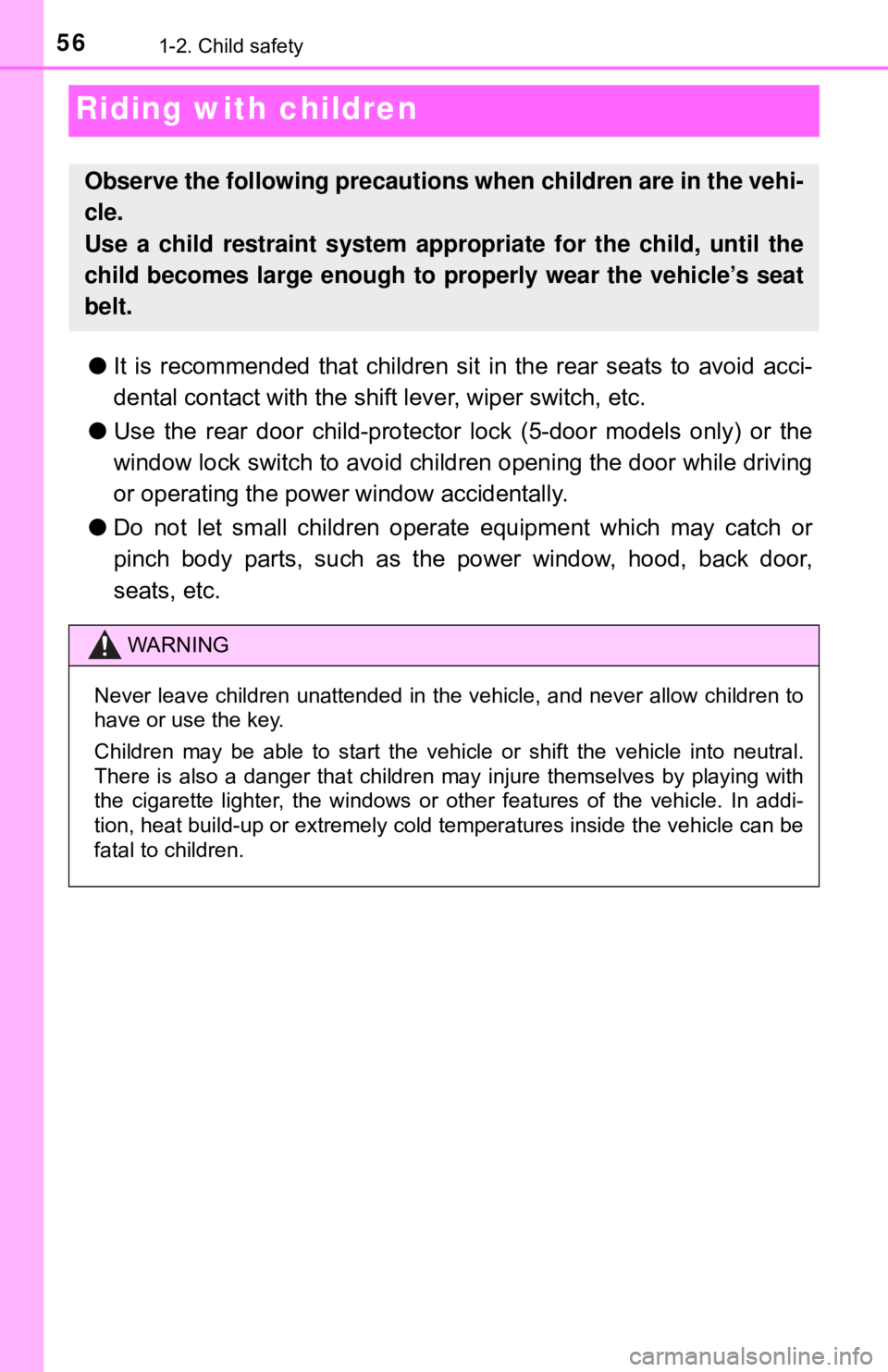
561-2. Child safety
Riding with children
●It is recommended that children sit in the rear seats to avoid acci-
dental contact with the shift lever, wiper switch, etc.
● Use the rear door child-protector lock (5-door models only) or the
window lock switch to avoid children opening the door while driving
or operating the power window accidentally.
● Do not let small children operate equipment which may catch or
pinch body parts, such as the power window, hood, back door,
seats, etc.
Observe the following precautions when children are in the vehi-
cle.
Use a child restraint system appropriate for the child, until the
child becomes large enough to pr operly wear the vehicle’s seat
belt.
WARNING
Never leave children unattended in the vehicle, and never allow children to
have or use the key.
Children may be able to start the vehicle or shift the vehicle into neut\
ral.
There is also a danger that children may injure themselves by playing with
the cigarette lighter, the windows or other features of the vehicle. In addi-
tion, heat build-up or extremely cold temperatures inside the vehicle can be
fatal to children.
Page 68 of 520
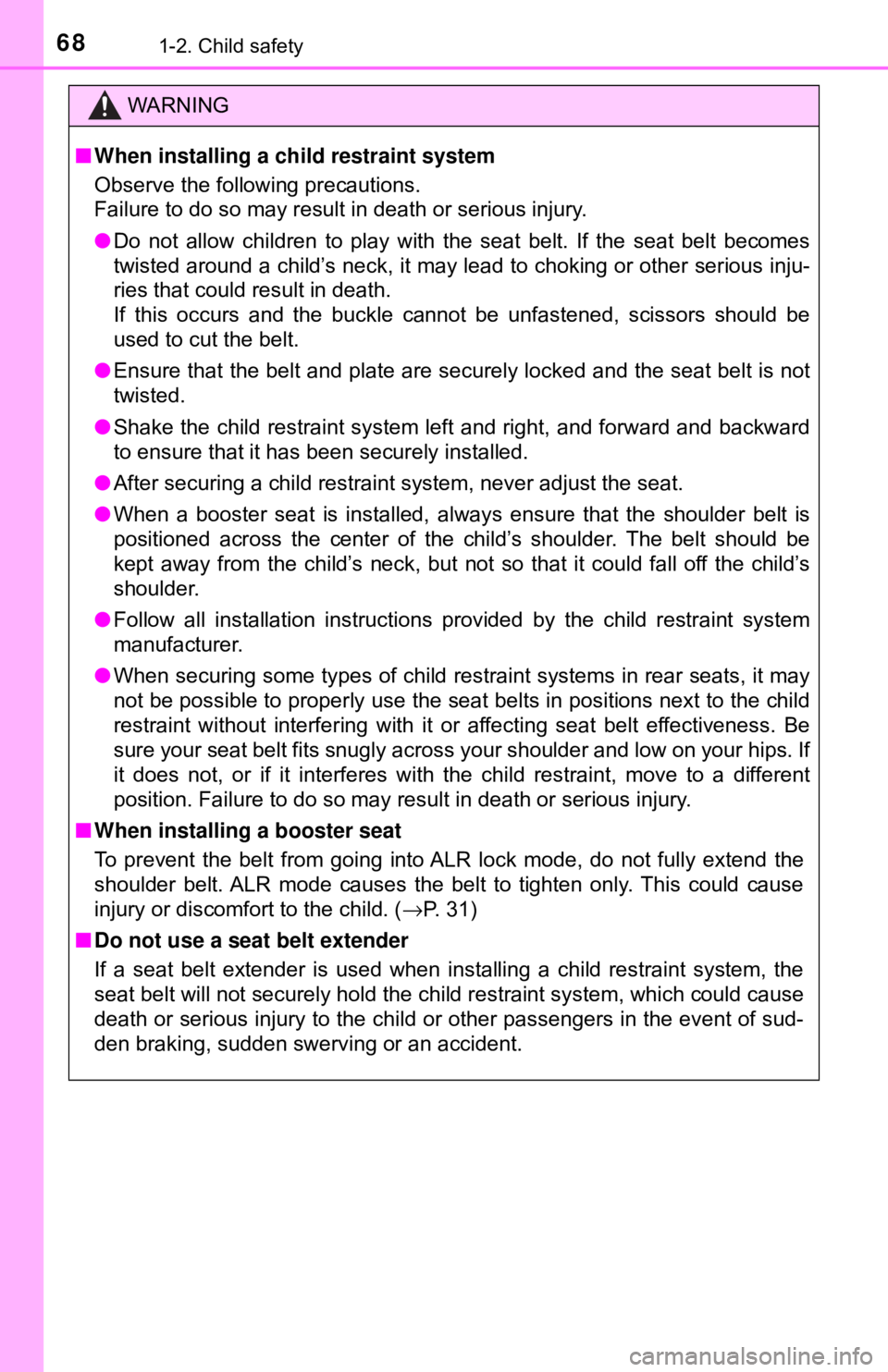
681-2. Child safety
WARNING
■When installing a child restraint system
Observe the following precautions.
Failure to do so may result in death or serious injury.
● Do not allow children to play with the seat belt. If the seat belt becomes
twisted around a child’s neck, it may lead to choking or other serious inju-
ries that could result in death.
If this occurs and the buckle cannot be unfastened, scissors should be
used to cut the belt.
● Ensure that the belt and plate are securely locked and the seat belt is not
twisted.
● Shake the child restraint system left and right, and forward and backward
to ensure that it has been securely installed.
● After securing a child restraint system, never adjust the seat.
● When a booster seat is installed, always ensure that the shoulder belt is
positioned across the center of the child’s shoulder. The belt should be
kept away from the child’s neck, but not so that it could fall off the child’s
shoulder.
● Follow all installation instructions provided by the child restraint system
manufacturer.
● When securing some types of child restraint systems in rear seats, it may
not be possible to properly use the seat belts in positions next to the child
restraint without interfering with it or affecting seat belt effectiveness. Be
sure your seat belt fits snugly across your shoulder and low on your hips. If
it does not, or if it interferes with the child restraint, move to a different
position. Failure to do so may result in death or serious injury.
■ When installing a booster seat
To prevent the belt from going into ALR lock mode, do not fully extend the
shoulder belt. ALR mode causes the belt to tighten only. This could cause
injury or discomfort to the child. ( →P. 31)
■ Do not use a seat belt extender
If a seat belt extender is used when installing a child restraint system, the
seat belt will not securely hold the child restraint system, which could cause
death or serious injury to the child or other passengers in the event of sud-
den braking, sudden swerving or an accident.
Page 69 of 520
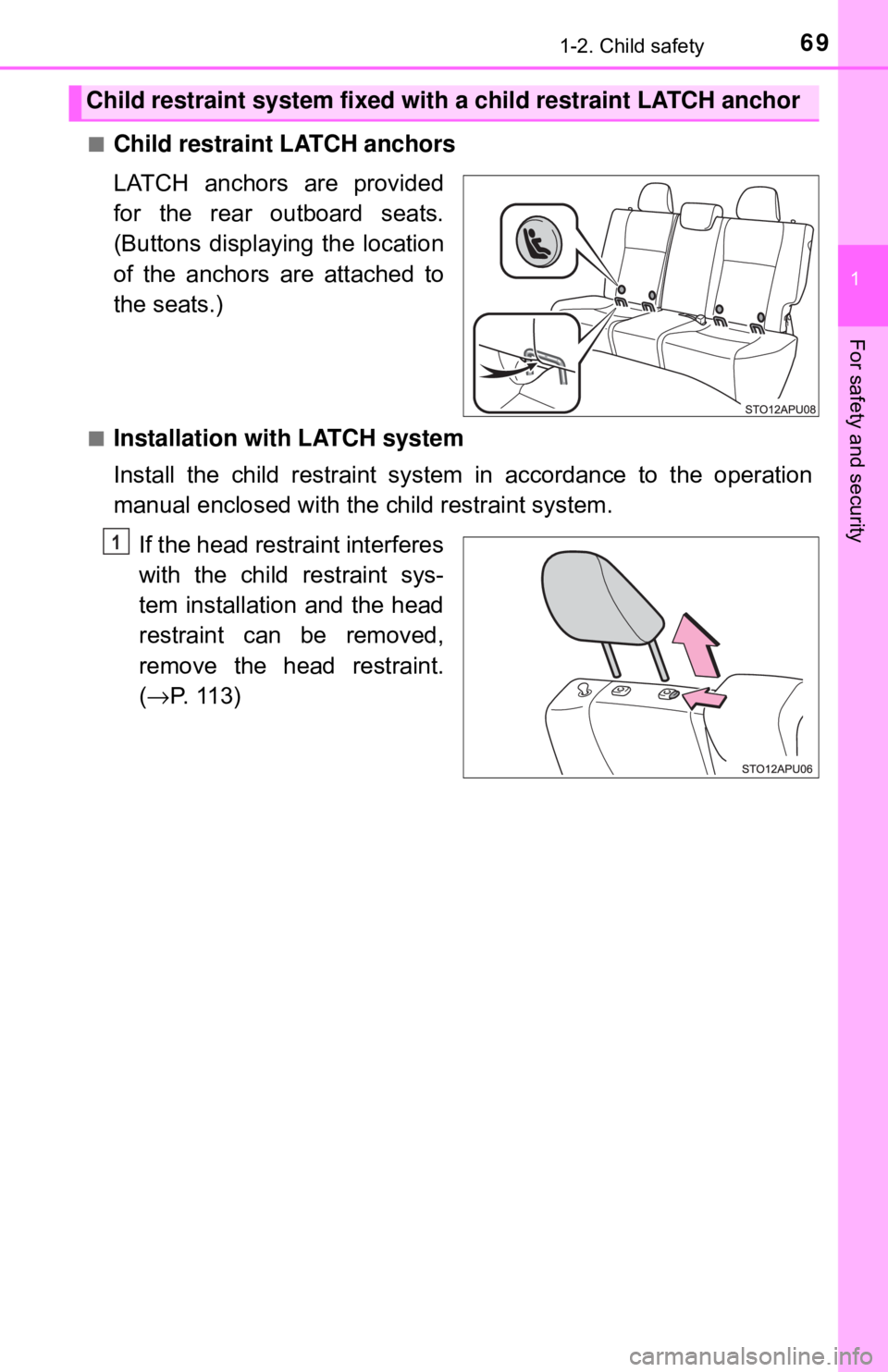
691-2. Child safety
1
For safety and security
■Child restraint LATCH anchors
LATCH anchors are provided
for the rear outboard seats.
(Buttons displaying the location
of the anchors are attached to
the seats.)
■Installation with LATCH system
Install the child restraint system in accordance to the operation
manual enclosed with the child restraint system.If the head restraint interferes
with the child restraint sys-
tem installation and the head
restraint can be removed,
remove the head restraint.
(→ P. 113)
Child restraint system fixed with a child restraint LATCH anchor
1
Page 71 of 520
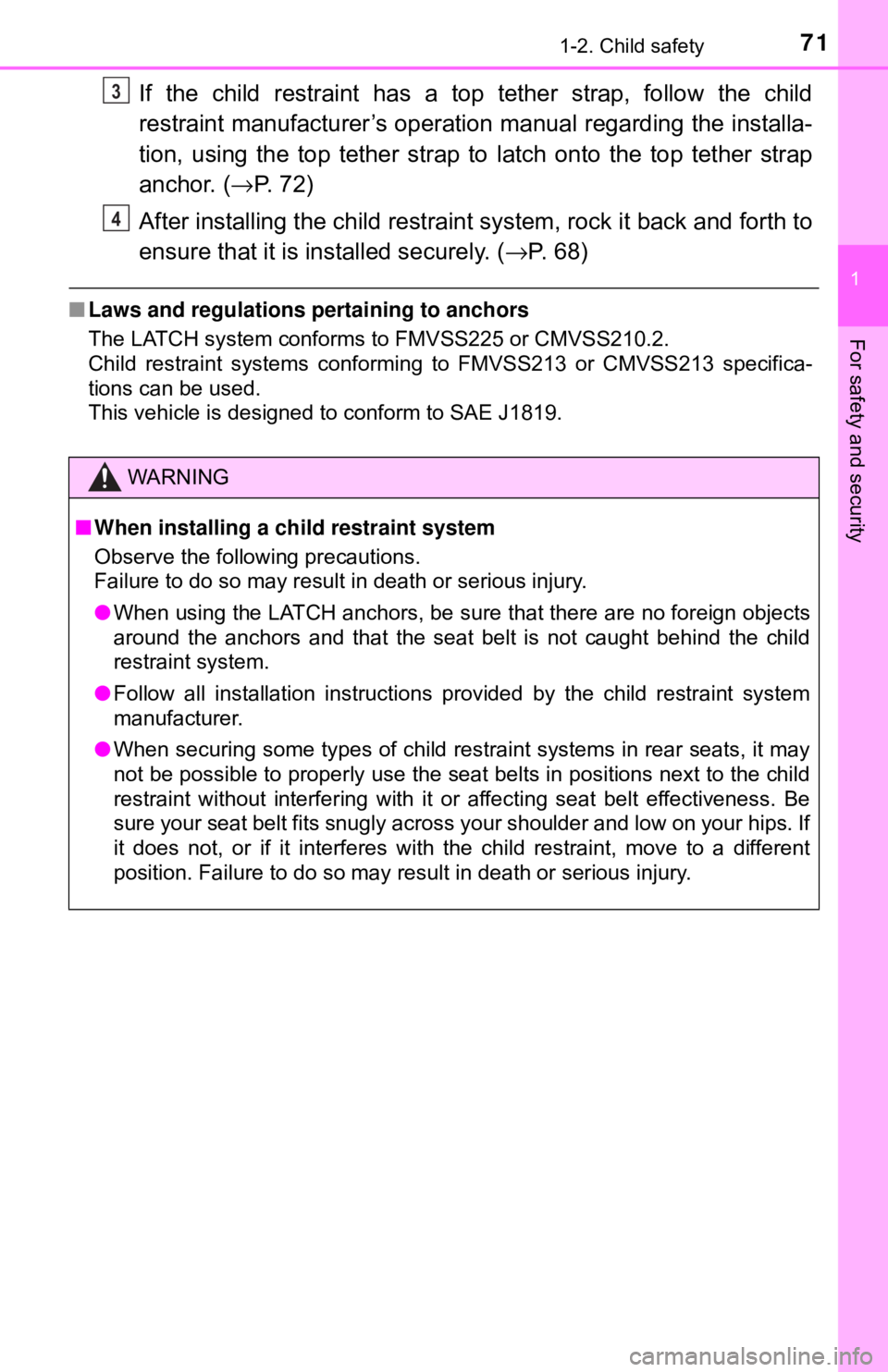
711-2. Child safety
1
For safety and security
If the child restraint has a top tether strap, follow the child
restraint manufacturer’s operation manual regarding the installa-
tion, using the top tether strap to latch onto the top tether strap
anchor. (→ P. 7 2 )
After installing the child restraint system, rock it back and forth to
ensure that it is installed securely. ( →P. 68)
■Laws and regulations pertaining to anchors
The LATCH system conforms to FMVSS225 or CMVSS210.2.
Child restraint systems conforming to FMVSS213 or CMVSS213 specifica-
tions can be used.
This vehicle is designed to conform to SAE J1819.
WARNING
■When installing a child restraint system
Observe the following precautions.
Failure to do so may result in death or serious injury.
● When using the LATCH anchors, be sure that there are no foreign objects
around the anchors and that the seat belt is not caught behind the child
restraint system.
● Follow all installation instructions provided by the child restraint system
manufacturer.
● When securing some types of child restraint systems in rear seats, it may
not be possible to properly use the seat belts in positions next to the child
restraint without interfering with it or affecting seat belt effectiveness. Be
sure your seat belt fits snugly across your shoulder and low on your hips. If
it does not, or if it interferes with the child restraint, move to a different
position. Failure to do so may result in death or serious injury.
3
4
Page 91 of 520
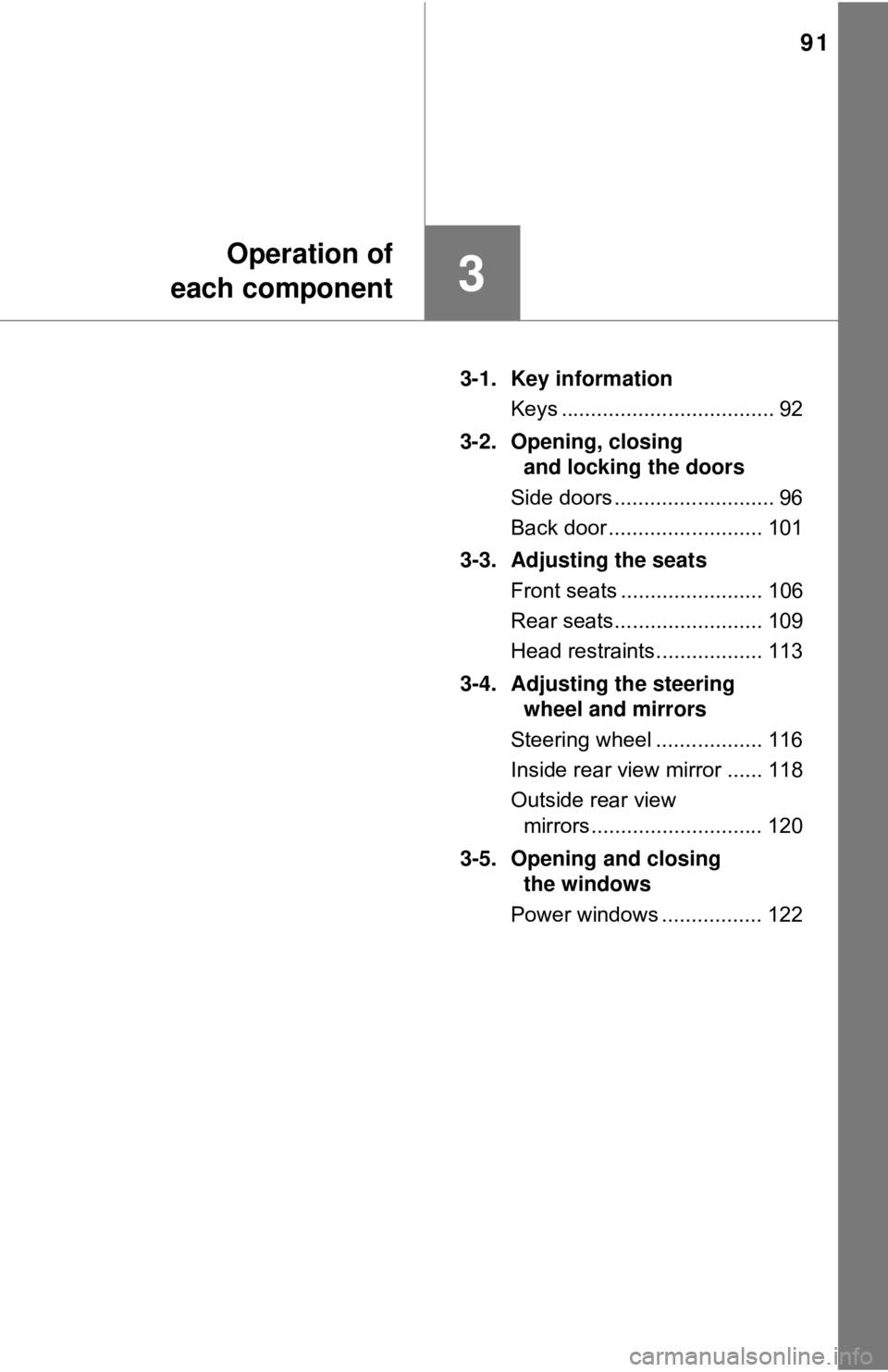
91
3
Operation of
each component
3-1. Key information
Keys .................................... 92
3-2. Opening, closing and locking the doors
Side doors ........................... 96
Back door .......................... 101
3-3. Adjusting the seats Front seats ........................ 106
Rear seats......................... 109
Head restraints.................. 113
3-4. Adjusting the steering wheel and mirrors
Steering wheel .................. 116
Inside rear view mirror ...... 118
Outside rear view mirrors ............................. 120
3-5. Opening and closing the windows
Power windows ................. 122
Page 100 of 520
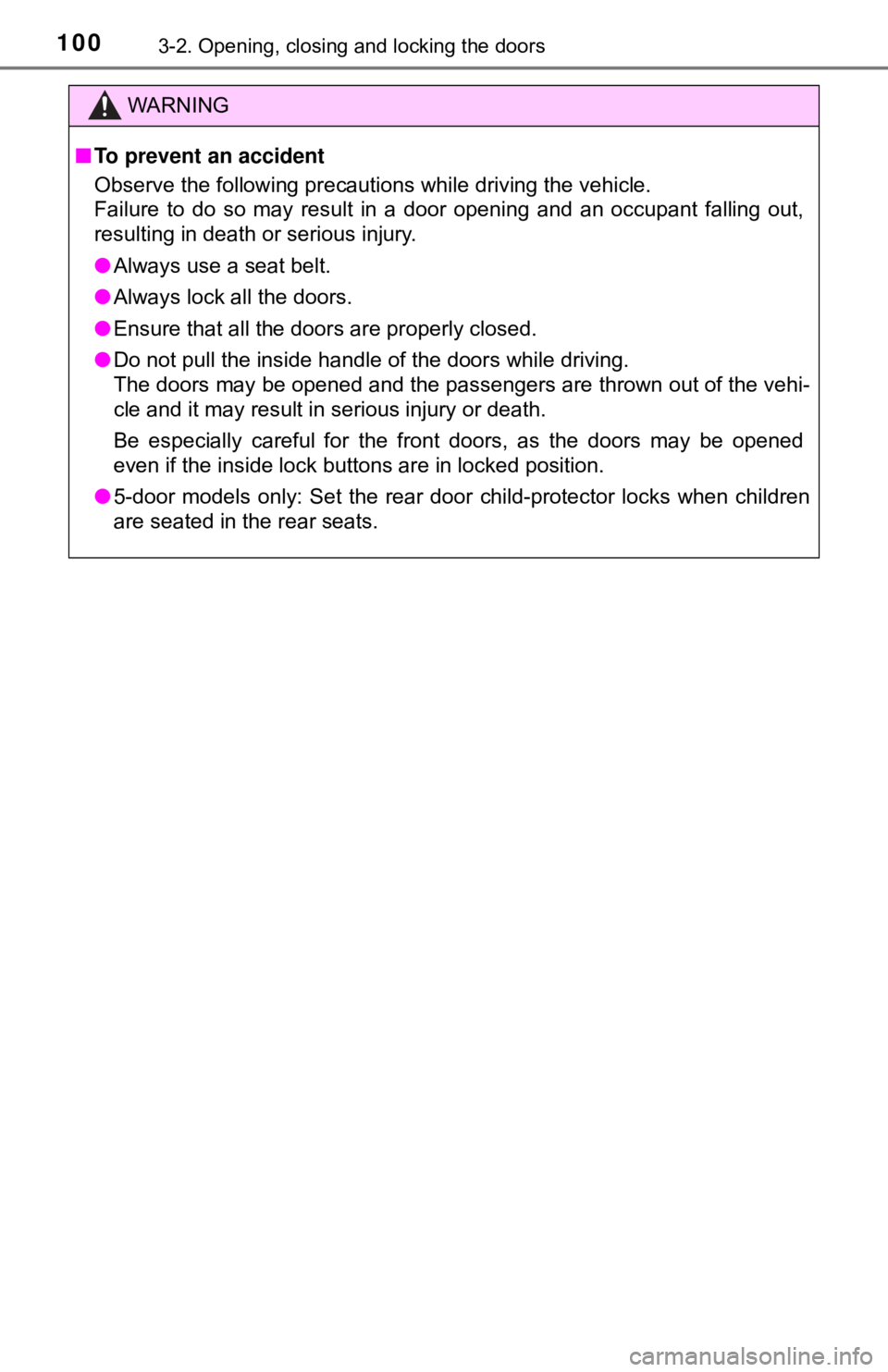
1003-2. Opening, closing and locking the doors
WARNING
■To prevent an accident
Observe the following precautions while driving the vehicle.
Failure to do so may result in a door opening and an occupant falling out,
resulting in death or serious injury.
● Always use a seat belt.
● Always lock all the doors.
● Ensure that all the doors are properly closed.
● Do not pull the inside handle of the doors while driving.
The doors may be opened and the passengers are thrown out of the vehi-
cle and it may result in serious injury or death.
Be especially careful for the front doors, as the doors may be opened
even if the inside lock buttons are in locked position.
● 5-door models only: Set the rear door child-protector locks when children
are seated in the rear seats.
Page 106 of 520
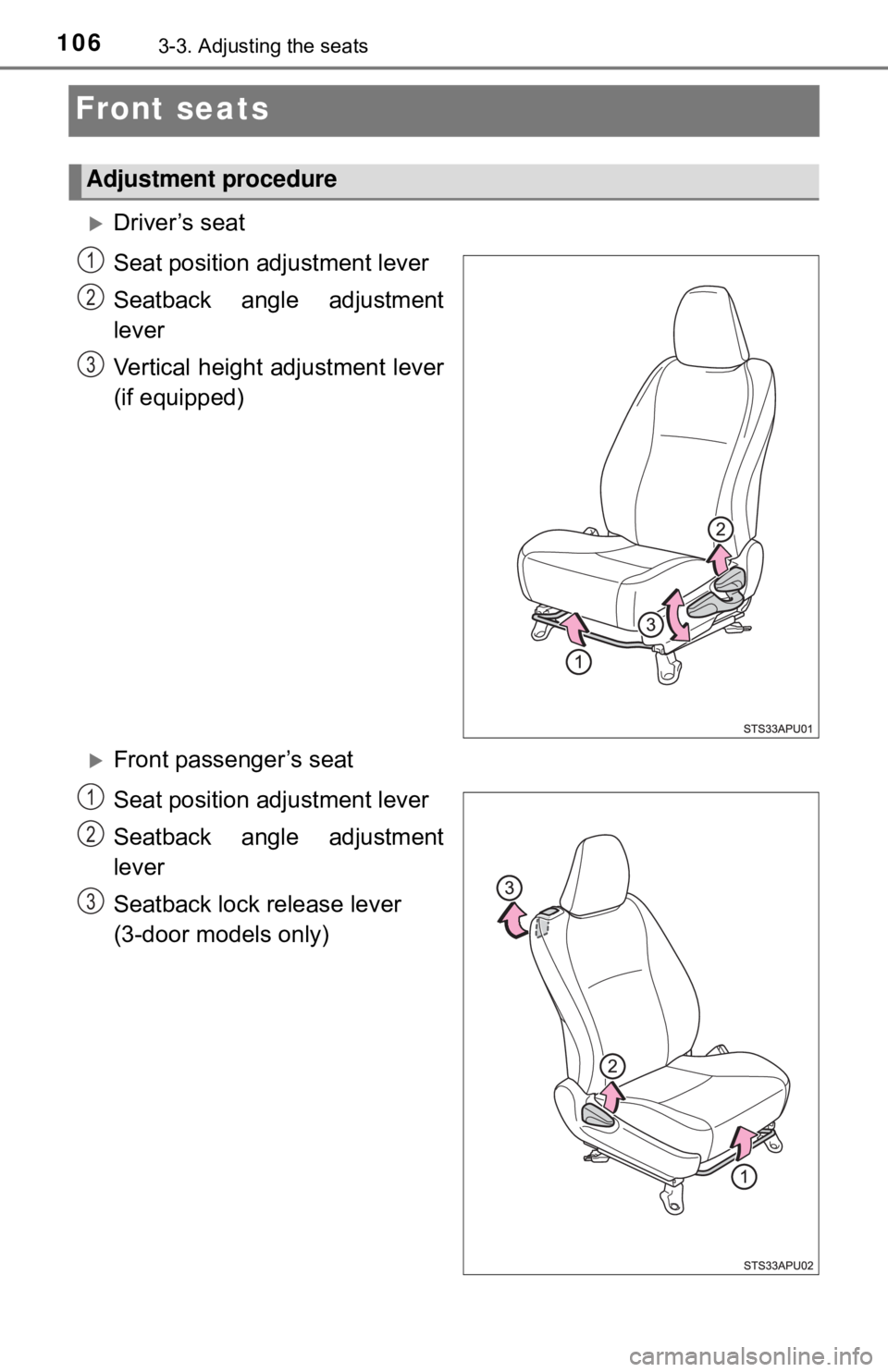
1063-3. Adjusting the seats
Front seats
Driver’s seat
Seat position adjustment lever
Seatback angle adjustment
lever
Vertical height adjustment lever
(if equipped)
Front passenger’s seat
Seat position ad justment lever
Seatback angle adjustment
lever
Seatback lock release lever
(3-door models only)
Adjustment procedure
1
2
3
1
2
3
Page 107 of 520
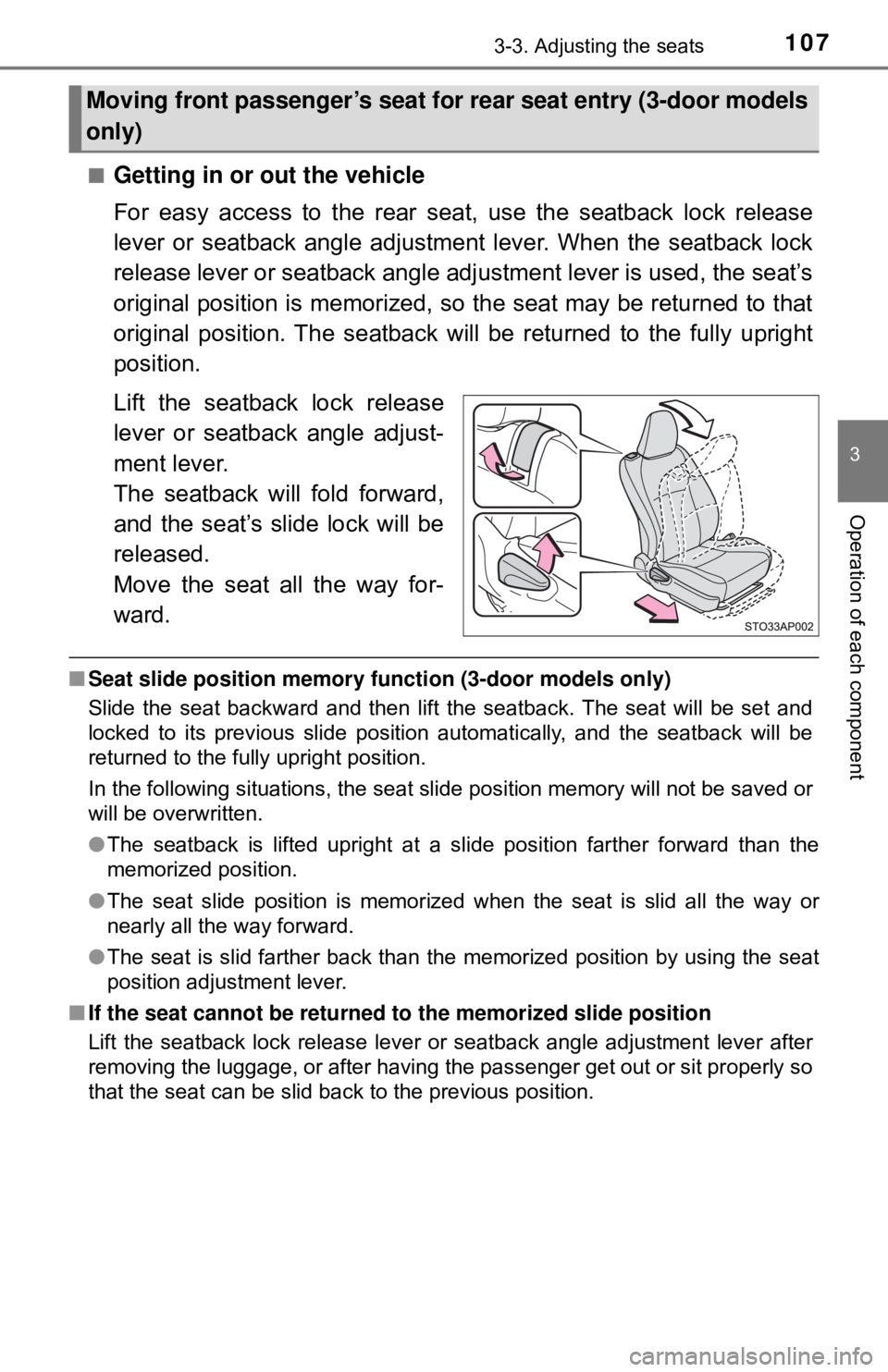
1073-3. Adjusting the seats
3
Operation of each component
■Getting in or out the vehicle
For easy access to the rear seat, use the seatback lock release
lever or seatback angle adjustment lever. When the seatback lock
release lever or seatback angle adj ustment lever is used, the seat’s
original position is memorized, so the seat may be returned to that
original position. The seatback will be returned to the fully upright
position.
Lift the seatback lock release
lever or seatback angle adjust-
ment lever.
The seatback will fold forward,
and the seat’s slide lock will be
released.
Move the seat all the way for-
ward.
■ Seat slide position memory fu nction (3-door models only)
Slide the seat backward and then lift the seatback. The seat will be set and
locked to its previous slide position automatically, and the seatback will be
returned to the fully upright position.
In the following situations, the seat slide position memory will not be saved or
will be overwritten.
● The seatback is lifted upright at a slide position farther forward than the
memorized position.
● The seat slide position is memorized when the seat is slid all the way or
nearly all the way forward.
● The seat is slid farther back than the memorized position by using the seat
position adjustment lever.
■ If the seat cannot be returned to the memorized slide position
Lift the seatback lock release lever or seatback angle adjustment lever after
removing the luggage, or after having the passenger get out or sit properly so
that the seat can be slid back to the previous position.
Moving front passenger’s seat for rear seat entry (3-door models
only)
Page 108 of 520
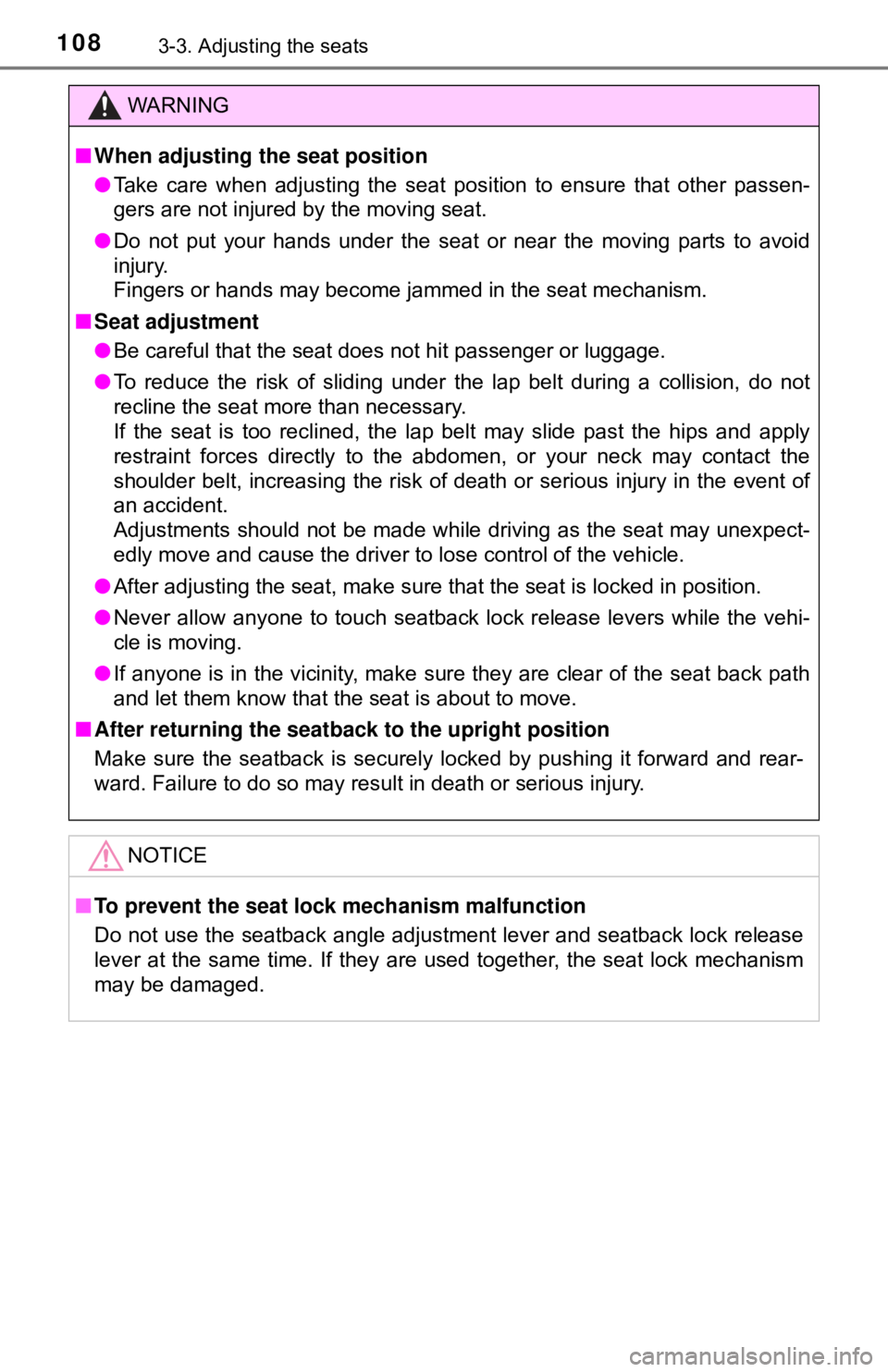
1083-3. Adjusting the seats
WARNING
■When adjusting the seat position
● Take care when adjusting the seat position to ensure that other passen-
gers are not injured by the moving seat.
● Do not put your hands under the seat or near the moving parts to avoid
injury.
Fingers or hands may become jammed in the seat mechanism.
■ Seat adjustment
● Be careful that the seat does not hit passenger or luggage.
● To reduce the risk of sliding under the lap belt during a collision, do not
recline the seat more than necessary.
If the seat is too reclined, the lap belt may slide past the hips and apply
restraint forces directly to the abdomen, or your neck may contact the
shoulder belt, increasing the risk of death or serious injury in the event of
an accident.
Adjustments should not be made while driving as the seat may unexpect-
edly move and cause the driver to lose control of the vehicle.
● After adjusting the seat, make sure that the seat is locked in position.
● Never allow anyone to touch seatback lock release levers while the vehi-
cle is moving.
● If anyone is in the vicinity, make sure they are clear of the seat back path
and let them know that the seat is about to move.
■ After returning the seatback to the upright position
Make sure the seatback is securely locked by pushing it forward and rear-
ward. Failure to do so may result in death or serious injury.
NOTICE
■ To prevent the seat lock mechanism malfunction
Do not use the seatback angle adjustment lever and seatback lock release
lever at the same time. If they are used together, the seat lock mechanism
may be damaged.
Page 109 of 520
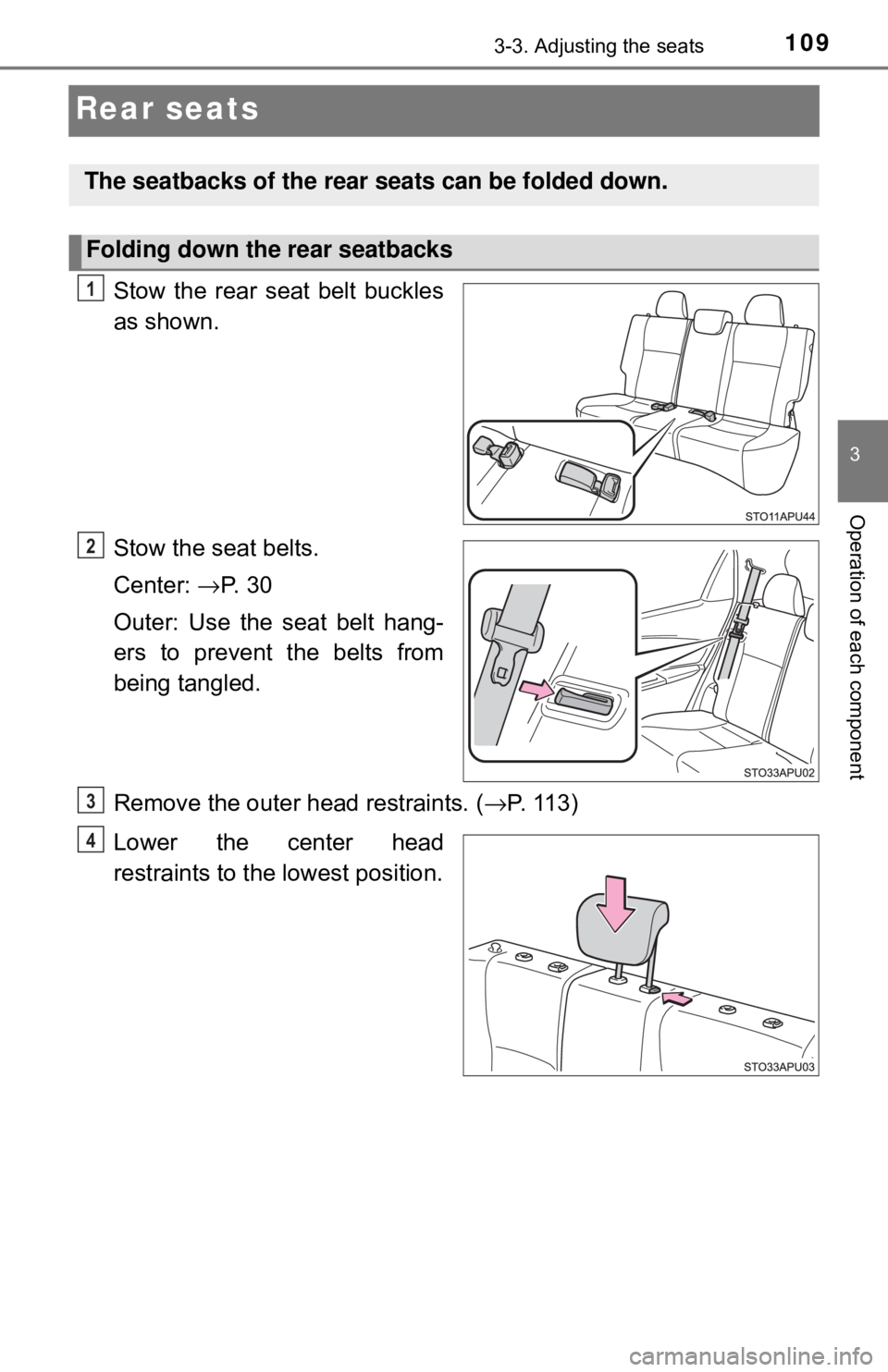
1093-3. Adjusting the seats
3
Operation of each component
Rear seats
Stow the rear seat belt buckles
as shown.
Stow the seat belts.
Center: →P. 3 0
Outer: Use the seat belt hang-
ers to prevent the belts from
being tangled.
Remove the outer head restraints. ( →P. 113)
Lower the center head
restraints to the lowest position.
The seatbacks of the rear seats can be folded down.
Folding down the rear seatbacks
1
2
3
4